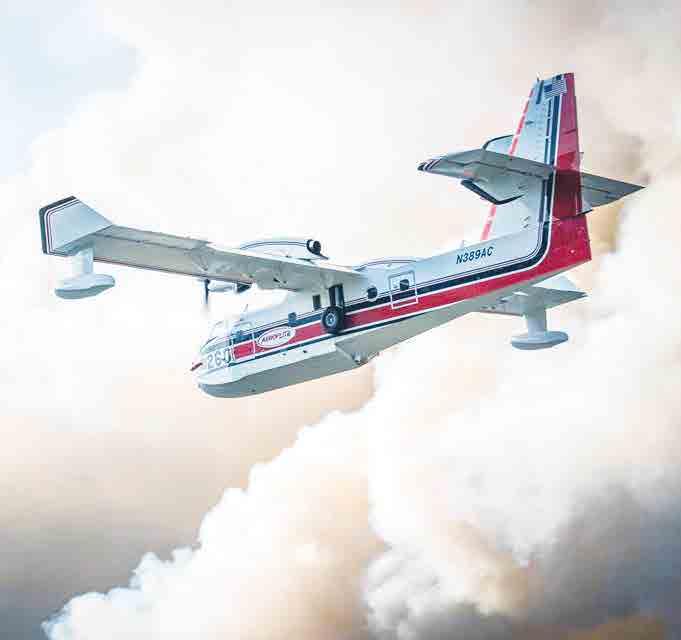
34 minute read
ATU MANDATES - ARE YOU READY?
Proposed Changes to USDA Contracts, are you ATU Ready?
Story by Stephane Momy
Keeping up to date and understanding the new proposed contract changes may be challenging and daunting for operators. This article aims to simplify some of the recently proposed changes to the upcoming 2022 aerial firefighting helicopter (AFF) support service contracts with the United States Department of Agriculture (USDA) and the United States Forest Service (USFS). Draft contracts have been made available for feedback. The proposed changes introduce several new service and equipment requirements for aerial firefighting helicopter support services.
Some of the main changes to these contracts include equipment requirements for Additional Telemetry Units (ATU) and Flight Data Monitoring (FDM) systems. Operators have expressed that some of these changes will be challenging in terms of overcoming financial and logistical obstacles. While the final contracts will not include all of these proposed changes, it’s safe to say the ATU mandates will become the new norm for their ability to measure accountability. The ATU mandates are in effect in other parts of the world.
They have been anticipated for a while to catch up with government agencies currently compliant and leading the integration and requirements of new supporting technologies. The ATU requirements apply for Type 1 and Type 2 rotorcraft and fixed-wing water bombers with the expectation that the program will expand to all aircraft. The ATU requirements should not be feared as this article will cover the background and importance of ATU, simplicity of integration, and cost-effective implementation.
ATU provides the valuable capability to measure water volumes and retardant (suppressant) type used, report associated GPS positions, over the air (OTA), where the aerial platform picks up the water volume, and where it is dropped to support firefighting operations. Typically, this GPS-tagged ATU information is then overlaid onto electronic geographical maps so that operators and government agencies can effectively manage the firefighting operation. The introduction of ATU is very similar to the introduction of Automatic Flight Following (AFF) in 2005 by the USFS. Government agencies originally introduced and mandated AFF for primary operator firefighting contracts, but it has spread into other jurisdictions and applications. We’re at the beginning of ATU, with government agencies demanding greater accountability with aerial firefighting.
Faced with more intense and more prolonged fire seasons, government agencies need to track the efficiency of their efforts, and basic flight tracking is not a good measurement of their efforts. The result is an ATU requirement to utilize accurate and tested costeffective solutions to properly manage operations. ATU systems integrate seamlessly with many existing AFF systems and work parallel with routine AFF position reports, resulting in aircraft sending both AFF and ATU GPS position reports.
The new contract requires operators to describe the ATU system installed on the offered aircraft during the bidding process. A few select vendors are providing this technology, including Guardian Mobility Inc. The ATU system must be active in all phases of flight and report information on; tank/bucket open, close, gallons filled, and gallons dropped events with GPS data (Date, Time, Latitude, Longitude, Altitude, Speed, and Heading).
Additional information may be requested for pump on/ off and coverage level. The data must be delivered to the government within two minutes of the event and not interfere with any AFF position reports. Like AFF, ATU follows the same format as the AFF JSON requirement. A web-based mapping application will automatically forward all ATU and AFF events to the required government system through a subscription service with a vendor such as Guardian Mobility.
Operators need to understand their overall system onboard their fleet and ensure it is appropriately configured, as load cells are used to provide ATU.
ATU vendors may have specific requirements for compatible load cell systems and bucket/ tank types as these systems trigger the actions and give the ATU data. Although ATU vendors can support most setups, not all load cells, buckets, and tanks from different manufacturers work universally, so it is critical to consult your ATU vendor for compatibility.
Counting on the reliability of ATU systems, the USDA is adding further requirements for information provided by operators. Under the new rules, operators must perform calibration tests for events including fill, open, and calculated volume drops no less than seven calendar days before the aircraft inspection. The vendor must validate that the system is reporting all data correctly at the calibration flight. Ensuring reliability and choosing an ATU vendor you trust has become critical for operators. If the ATU information becomes unreliable, a 14-calendar day window is given from the date the reliability issues were discovered to get the system back to full operation. Otherwise, the failure could lead to grounded aircraft and mission-critical issues. ➤
USFS ATU requirements were first introduced in 2018 and are expected to grow in 2022. New proposed contract regulations will expand where operators require this equipment and the reliability of the systems in place. These new elements were introduced in draft contracts for the 2022 fire season; however, with delays at the USFS, a new finalized agreement will not be in place before the start of the 2022 fire season. Ultimately current contracts are being extended into the upcoming fire season, and we can anticipate seeing the new finalized contracts realized at the end of the summer/fall 2022 timeframe.
The draft contracts introduced several other requirements for the contractors facing pushbacks and delays, but this has not stopped operators from preparing for the upcoming contract changes. Operators know these changes will be coming soon and want to ensure that they are ready once established.
ATU vendors have seen an influx in demand for this technology as operators purchase and install their ATU equipment. Many choose to purchase and install these low-cost systems ahead of the finalized contracts to better understand their capabilities and familiarize themselves with how they work.
To become compliant, operators must purchase a system that meets all requirements from approved ATU vendors. In addition to the ATU system, a bucket and/or tank must be used, as discussed in the requirements. When a bucket is used, a load cell system must be installed to provide the ATU system with the load readings. Vendors such as Guardian Mobility provide a complete end-to-end solution for the ATU, AFF, text messaging, and more as shown in Figure 1.
The main components in Guardian Mobilities ATU setup are the on aircraft G4MX2 black box, the GMI connect smartphone app, and the mapping system and GM servers.
G4MX2 black box: The G4MX2 unit is a small, lightweight single-box solution that is installed in any convenient location that allows for either GPS and Iridium patch antennas to view the sky or an externally mounted GPS/ Iridium combined antenna to be installed. While most ATU vendors have opted for a dual box setup that has an ATU-specific processing box and an AFF communication box, Guardian Mobility’s unique G4MX2 devices offer an all-in-one box package.
This single box setup has several advantages including the lower cost for operators and minimal installation requirements using a single box. In addition, having one box from the same OEM makes support more streamlined than a multi-box setup. The G4MX2, when wired according to the installation manual, can support either Bambi or fast buckets, an Isolair tank only system, or a “Combi” mode of both buckets and tanks, depending on whether a bucket or tank is installed for aircraft operation.
The Bambi and fast bucket interface uses discrete inputs for bucket and pump activation detection and a differential analog input for measuring the weight of the bucket and water hung on the rotorcraft hook using the existing aircraft bucketload cell indicator analog output. The Isolair tank interface uses the existing discrete wiring for the Isolair tank, isolated by relays, to detect tank door activation and tank pump as well as additional analog inputs configured to support the tank water level float switches.
Additional discrete inputs are used to determine whether a tank or bucket is currently installed. Guardian Mobility is committed to future developments and continues to integrate new setups such as the DART, Water Hog, and Cloudburst bucket types. Guardian can provide a satellite airtime subscription that is required for the G4MX2 to share events and location information with the mapping system in near real-time.
GMI connect smartphone APP: The GMI connect smartphone application allows operators to connect through Bluetooth to configure a G4MX2 and enables two-way text messaging with the mapping platform. The operator uses the passwordprotected Admin/Maintenance mode of the APP to configure some or all of the ATU operations.
Once all configuration items have been adjusted the G4MX2 will report the ATU and AFF data, without any aircrew involvement, on every subsequent flight. Generally, the Aircrew is not required to interact for ATU or AFF reports unless there is a change in the size or type of bucket. In this case, the operator can easily adjust their settings to ensure accurate ATU reporting.
Mapping system and GM Servers: The mapping application is a powerful software application that can be accessed globally and overlays AFF tracking and ATU reports. Other features include text messaging, map overlays, mark position events, and alert reporting. All AFF and ATU data is automatically forwarded with the required JSON outputs for government agencies.
Finally knowing what ATU is, how it will affect operators, and what is required for an ATU system, the question is how much will this all cost? Complete hardware and service packages are flexible, highly customizable, and extremely cost-effective. Whether you need large data packages, pay-as-you-go options or flexible suspend options for the off-season, there are packages to fit your needs.
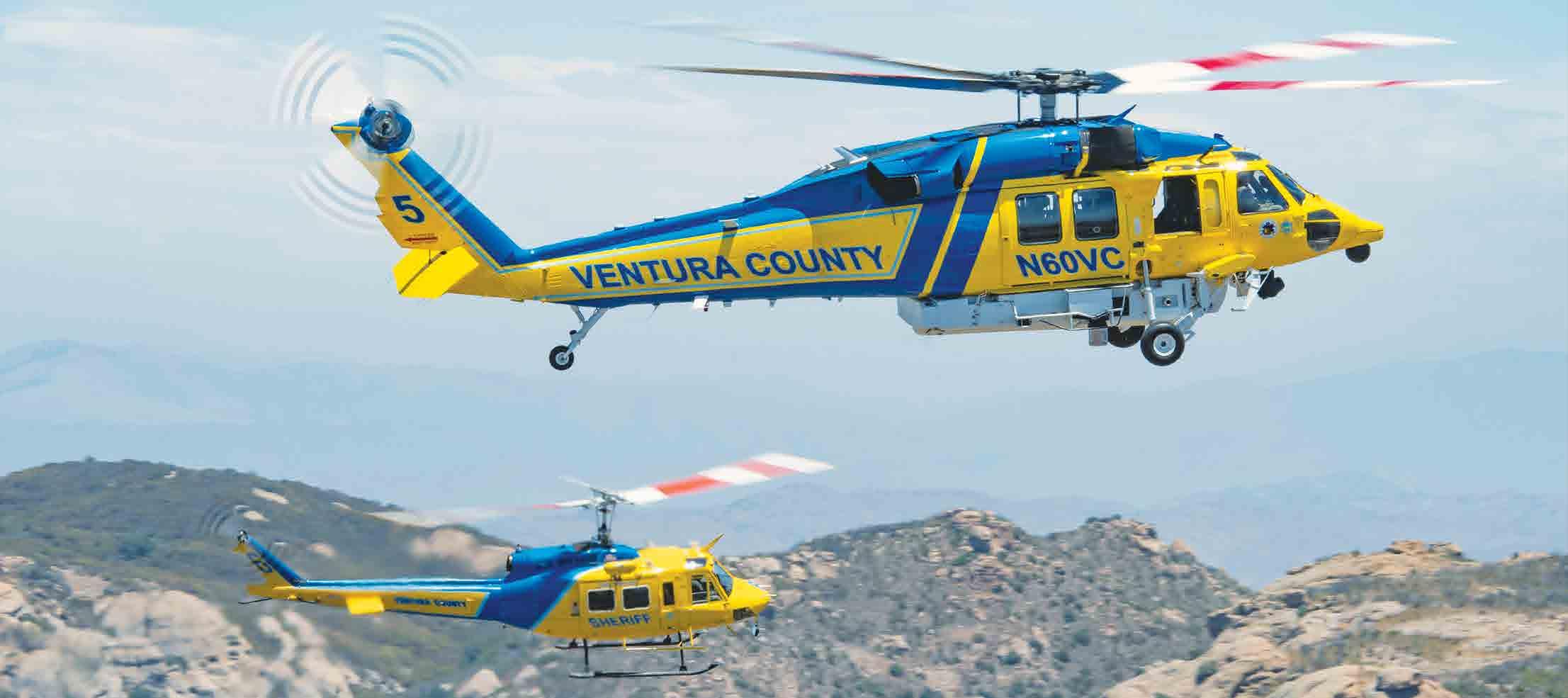
The oldest and the newest of the Ventura County fleet.
Ventura County, situated north of the Los Angeles Basin, is known for its varied terrain, farming, and beaches. The county is home to over 846,000 residents, and its 2,200 square miles are overseen by one of the more unique aviation units in the country. The county’s aviation unit is made up of aviators and crew members that come from both the police and fire departments, providing needed skill sets to the team for their many and varied mission types that span everything from police patrol, search and rescue, and aerial firefighting operations throughout the county.
The county aviation unit was founded in 1971 with a single Bell 47 aircraft, progressing to the Bell 205 in 1973, eventually securing three of the aircraft through the 1033 military surplus program. Until 1994, when the unit picked up a UH-1H, progressing through the years to now have nine airframes, including a Bell 206L acquired in 2010, a Bell 212, and three Blackhawks, which began arriving in July of 2017.
Unlike similar programs that began acquiring the Sikorsky S-70i and outfitting it as a Firehawk, Ventura County took a unique approach to upgrading its firefighting and rescue capabilities by securing three HH-60L model aircraft from the Army National Guard, which used these aircraft in combat search and rescue configuration. The HH-60L models secured by Ventura were three of only ten available at the time, unlike the much more common UH-60A models, which are becoming extremely popular acquisitions by contract firefighting companies. 1600 hours of flight time on each aircraft. Significantly increasing the overall lifespan of the aircraft with the agency when compared to the much higher timed Alpha models that are now being released into the market. The Lima models, of which only 28 were produced, have larger engines than the Alpha model, along with an upgraded gearbox. Although not as complex electronically as the Army Mike model, the Lima does have some digital switchology in the cockpit, with several MFD’s, although it still has a mix of analog cockpit information systems.
Thanks to some significant groundwork put in by the aviation unit and the county management on the Sheriff and fire department sides, along with county supervisors. The county purchased and picked up two helicopters through the federal government BEST program within ten days of agreeing to buy the aircraft—the third helicopter arriving a year later in 2018.
Once the HH-60L helicopters were on site, the more significant task of outfitting the aircraft began. While type training started on the aircraft for the pilots, the first aircraft to be transitioned into a fully-fledged rescue and firefighting helicopter was flown to United Rotorcraft in Colorado, where completion services included adding a Kawak tank extended landing gear to accommodate took place.
“Our goal was never to run buckets operationally. We purchased three Blackhawks with the idea we’re going to tank each one, but as budgets allowed, build time turned into three years, so out of necessity, we put a bucket on an aircraft until we received the first tanked aircraft,” said pilot Alex Kelly. ➤

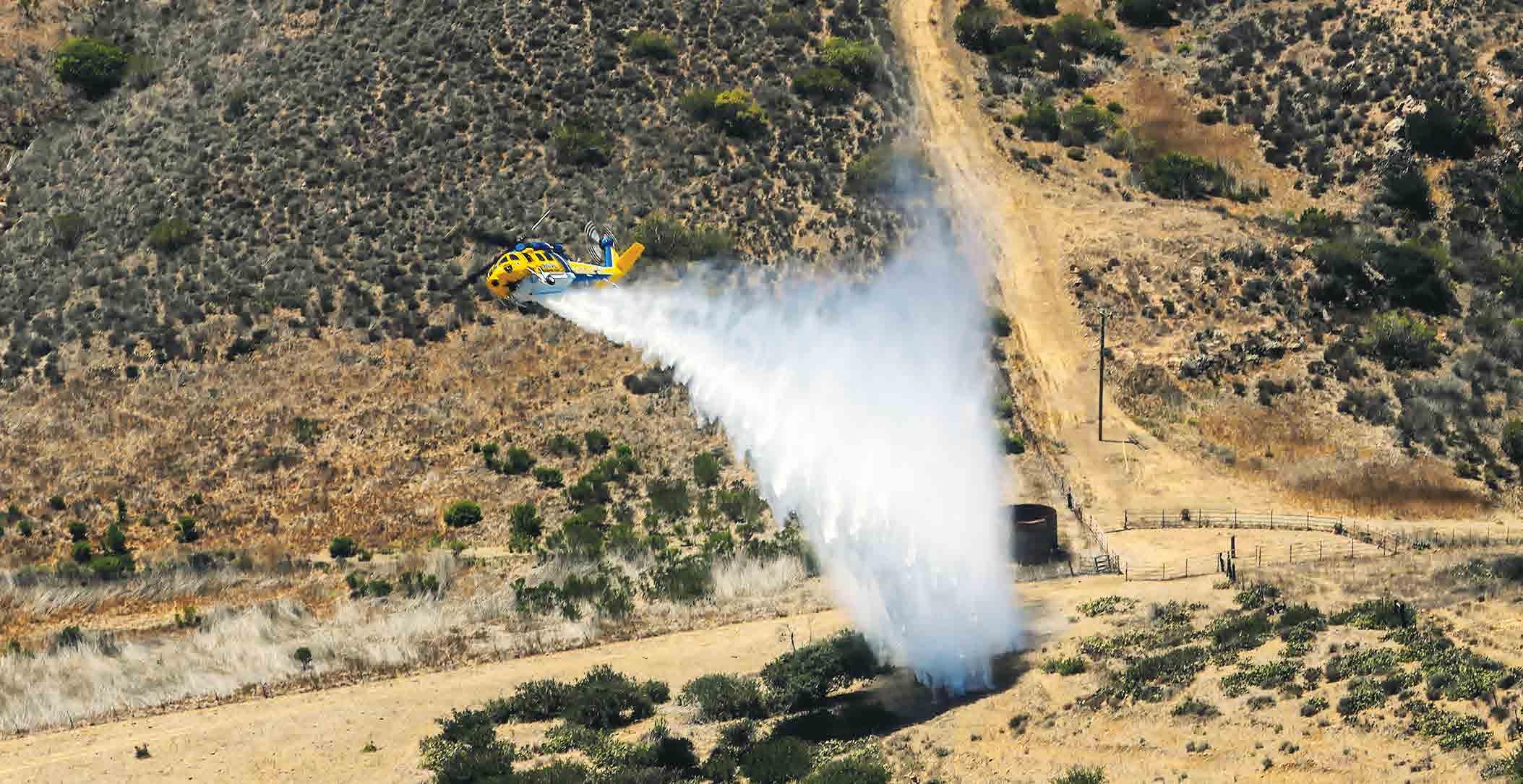
Ventura County’s new hawks are capable of multi-mission deployment for anything from search and rescue to firefighting.
During the selection process that led to the purchase of the Blackhawks, Aviation Unit Manager Mel Lovo detailed that they did look at the value for money of other aircraft, including the Bell 412, the AW139, and the stock S-70i Firehawk. Still, when it came down to budgets, they had to get creative, which led to the acquisition of a non-standard aircraft type that is now outfitted with equipment on par with the much more costly S-70i while still staying within their annual budget spends.
Because the HH-60L was not a standard S-70i airframe, this led to some design challenges, said unit member Jim Dalton. “There were many things on this build that had to be custom created by United Rotorcraft; they removed 527 pounds of existing wiring throughout the stripping process of the aircraft before the complete refit took place. Custom equipment fitted for the Ventura 60s included dual Garmin GTN 750s, 500 TXI displays, and multiple changes made to the cockpit configuration that benefit single-pilot operation versus the dual pilot configuration that the UH-60 previously operated as in its military configuration.

Flight Transitions
Moving from the much smaller airframes of the UH-1H and Bell 214, pilots needed to be trained to fly the new airframe as the aircraft was being fitted out, and maintenance checks took place in Alabama. The training of pilots was conducted by the former chief test pilot for Sikorsky, Kevin Bredenbeck, who now does a great deal of work on the United Rotorcraft led S-70i program that includes pilot training and aircraft check flights before acceptance as one of the most knowledgeable people in the industry on the Sikorsky airframe.
In addition to intensive flight training and emergency procedures with Bredenbeck and the United Rotorcraft team, pilots also completed initial flight training at Flight Safety on the UH-60 airframe as part of their training program. The Ventura pilots and crew members, in addition, have designed their own crew training that involves both the pilot and the front seat crew member, that can still be responsible for several parts of the operation of the aircraft at times or in the event of an emergency, crew members have their duties to perform in the aircraft in the event of an emergency situation. All left seat trained flight crew members are also trained at flight safety with the pilots to act in the event of an emergency as another layer of safety for the aircraft and additionally take at least 10 hours of initial flight training in a Robinson before attending training at Flight Safety in addition to continued flight training being offered in the aircraft on non-operational flights.
Legacy Aircraft
As a unit with multiple airframes, the newly revamped HH-60L’s are the future of the unit’s progression, although each aircraft still play a part in the day-to-day operation of the unit. The county’s two Bell 205’s are nearly 50 years old with 30,000 flight hours, along with the other aircraft, including the Bell 206L, which was refurbished just a few years ago, will see the unit through the next 20 years.
Fiscal Responsibility
Even as the unit grows its aircraft fleet with the addition of the new hawks, it is evident that both halves of the joint unit have longevity and budgetary concerns at the forefront to ensure the long-term survival of the unit. “Maybe 50% of our rescues may be one person lost in the woods, we would not necessarily send the hawk out for that mission when it can be completed by an equally capable 205 with a hoist, so in that case, we would use a legacy aircraft and dispatch one of our smaller aircraft unless there was a maintenance issue preventing that,” said Lovo in regards to dispatching aircraft for missions.
Fire Operations

Ventura County is one of six counties in California where CAL FIRE has a contract to provide aerial firefighting services, including L.A County, Orange County, Santa Barbara County, and several others that relieve CAL FIRE from the need to provide immediate resources or provide aircraft and bases to those counties to fight wildfires. Ventura and other counties receive reimbursement through the FC107 program through the US Forest Service and CAL FIRE for their participation in firefighting operations, which was explained as Ventura County acts as somewhat of a “contract” or chartered aerial firefighting operation when needed to fight large scale wildfires and work in conjunction with other aerial firefighting assets on large fires in any of the state and federal land located throughout their large response area. ➤

Search and rescue is a significant part of the missions flown by Ventura County thanks to a large amount of state and national parks land within the county.
Mission equipment on each HH-60L includes a Kawak tank, FLIR EO/IR system and an optional searchlight in addition to a Goodrich rescue hoist and numerous internal upgrades.
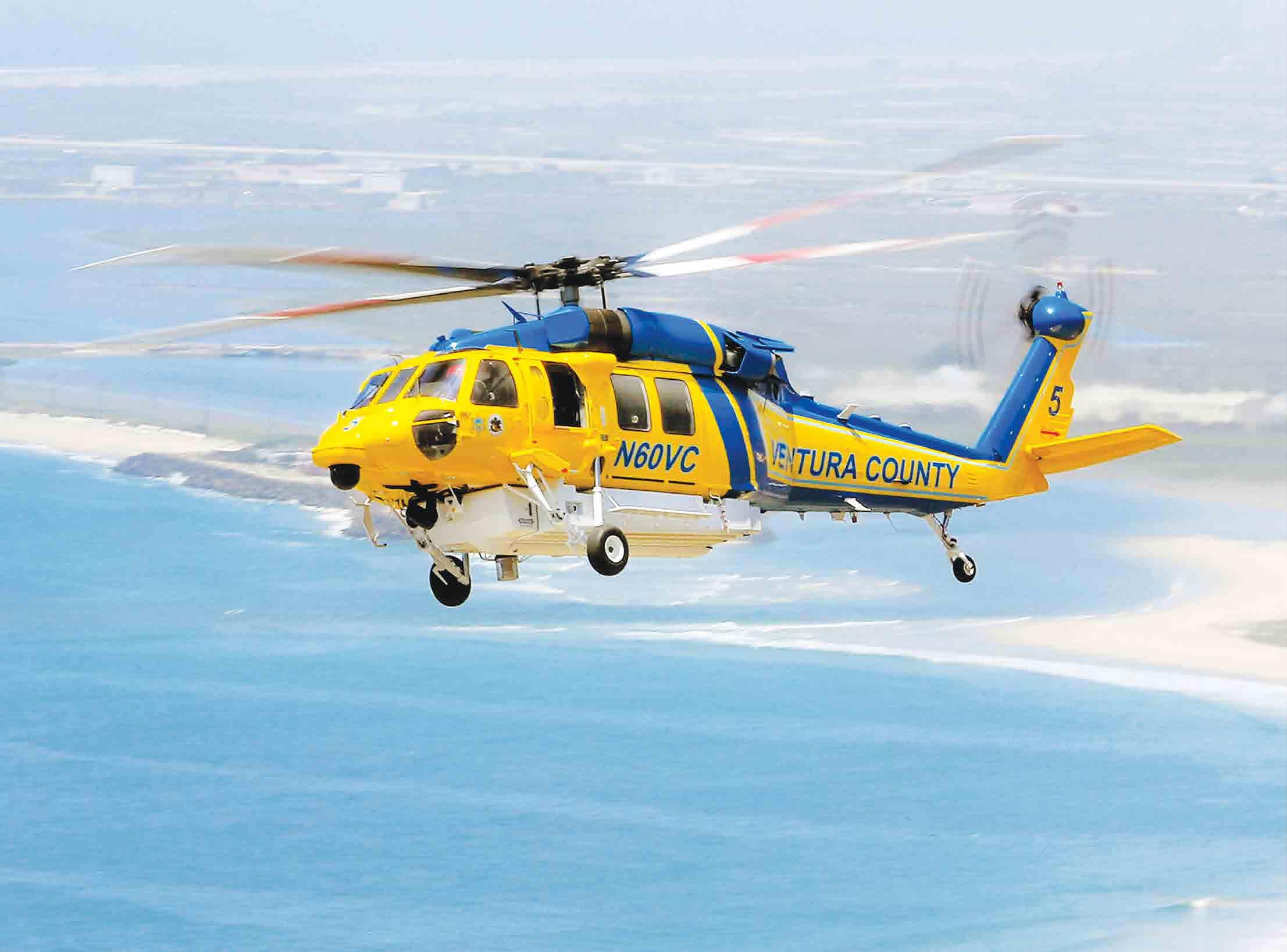
If mutual aid is requested for firefighting, Ventura aircraft will respond to surrounding counties like Santa Barbara and Orange Counties or others nearby. Still, unlike some other counties that will be deployable statewide, Ventura aircraft will stay within a reasonable distance of their home county as the department does not see a benefit to providing statewide support, nor does the county factor in state or federal reimbursement for firefighting operations into their annual operational budget.
As a large aviation unit with multiple mission profiles and aircraft, the unit flies approximately 120 hours on fires a year, with a total average of flight hours each year between the nine aircraft fly between 1000-1200 hours annually. 30% of those hours being training flights that can vary for more significant fire seasons. With the hawks only coming online recently, there is still an unknown quantity of hours the hawks will be flown on both fire operations and other missions that include flights to offshore locations within the county, such as the Channel Islands National Park and Santa Rosa island that sit 16 nautical miles off the coast of Ventura County that the county is responsible for. The unit requires a twin-engine aircraft to fly to.

Maintenance
the agency has spent years building up a parts inventory for its Bell products and is now in the process of doing the same for the Blackhawks that are new to the agency in the hopes that as problems arise, there will be sufficient parts to keep all aircraft operational for when they are needed. As far as the Blackhawk maintenance goes, internally, the agency can do 40-hour services on the aircraft. Still, larger maintenance tasks will be sent to outside vendors such as Arista Aviation in the past. The agency is working on a master agreement with United Rotorcraft for PMI’s and all other large maintenance tasks.
Equipment Upgrades
Although the agency currently operates the older Starfire FLIR system currently on both Blackhawks, they have taken delivery of two L3/Wescam LX-15 units that will be fitted as the fire season winds down. The demand for the hawks lowers, allowing the agency to fit the two new EO/IR units that will give them the ability for both day and night usage. In contrast, the older Starfire units were previously only capable of night use. The new camera units will be used across the spectrum of the unit’s missions, from search and rescue to law enforcement missions, with unit members looking forward to what the new system will provide for night firefighting missions, providing additional safety and vision to night loading of water during fire operations. ➤
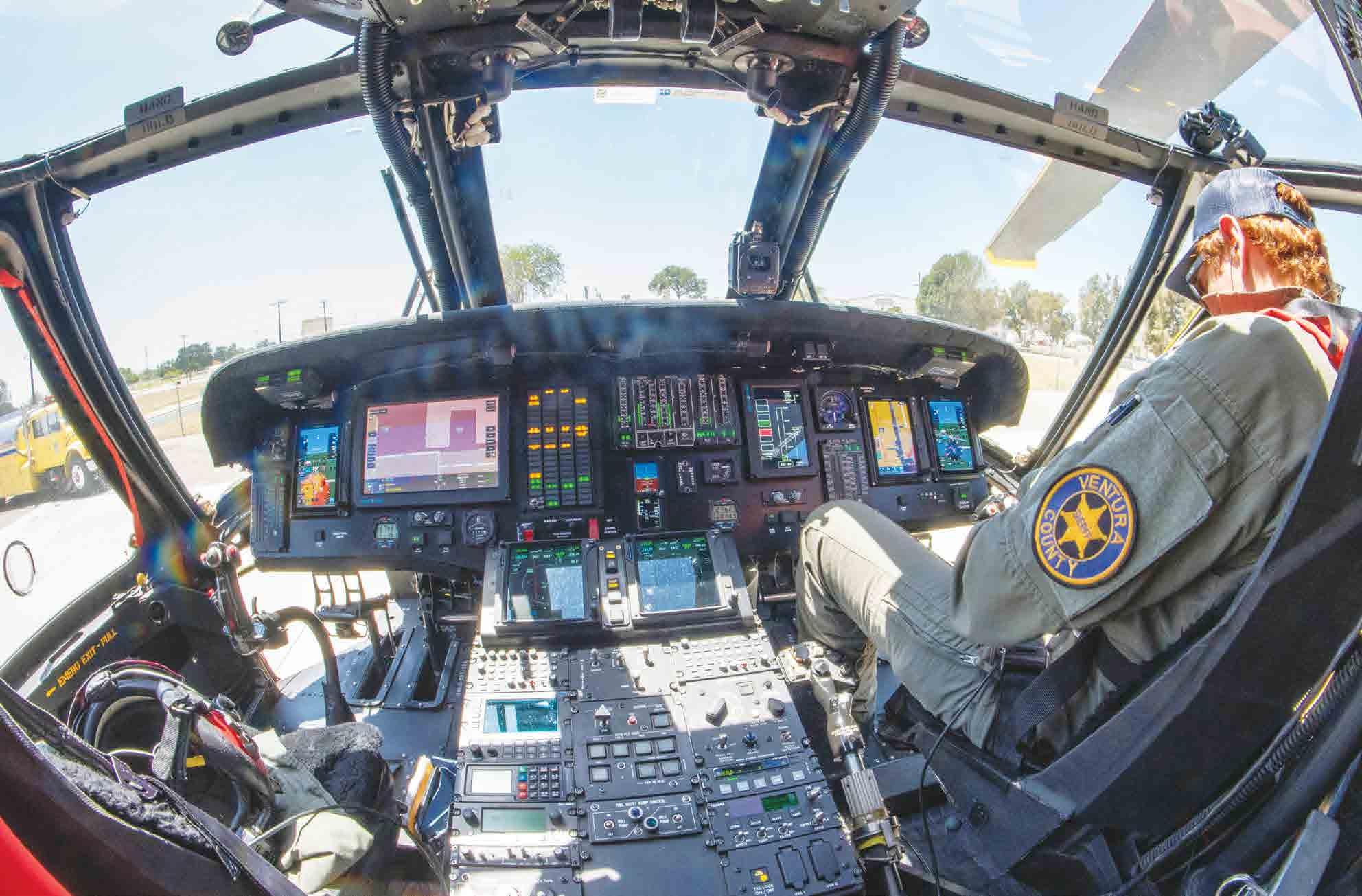


Staffing
Joint aviation units, at times, can be a complex operation of how the unit is staffed and who pays for what within the unit; however, Ventura County, over its more than 40 years in operation, has become symbiotic in how they continue to keep the aviation unit functioning. All pilots provided to the unit come from the Sheriff’s department side of the house. While there was previously a requirement for pilots to be deputies, only Jim Dalton remains the last sworn Sheriff’s deputy pilot from the Sheriff’s department. Maintenance employees are civilian employees that are also paid for by the Sheriff’s side. At the same time, rear crew members can consist of a mix of Sheriff’s department members and fire department crew members.
The unit employs two senior deputies and a sergeant as crew chiefs, in addition to two firefighter-paramedics and a fire captain who function in that role consisting of 22 crew members that are a mix of staff from both agencies that serve as crew for each flight as needed for daily staffing in addition to five pilots and one reserve pilot.
In addition to full-time staffing, Ventura County partners with local hospitals that also provide medical staffing for search and rescue missions that consist of multiple doctors, nurses, and paramedics that are made available daily from 7 am to 7 pm on-site for search and rescue missions where field medical intervention may be necessary.
Training
While training for pilots and full-time staff is an ongoing monthly requirement for unit staff members and is sometimes conducted daily, the unit also focuses on the training and certification of its volunteer medical staff in hoist operations, water egress (HUET), and helicopter offloading drills every month that keep all of the crew’s skills sharp and focus heavily on crew resource management to keep their operations smooth, precise and as safe as possible for both aircrew members and those in need of assistance during rescue. evolutions.
Operations
The Ventura County aviation unit is currently staffed with eight staff able to respond anywhere in the county within 25 minutes from 7 am to 7 pm for everything from a standard law enforcement flight to provide overwatch on a scene to a significant fire or rescue situation and provides on-call flight crews every day for the hours outside of their regular coverage periods. Over the nearly 50 years of operation of the unit, while aircraft may have changed, improved, and become more capable, the passion for providing a high level of support and response is evident in the drive of every member of the unit as they continue to provide a high-quality service to the citizens of Ventura County.

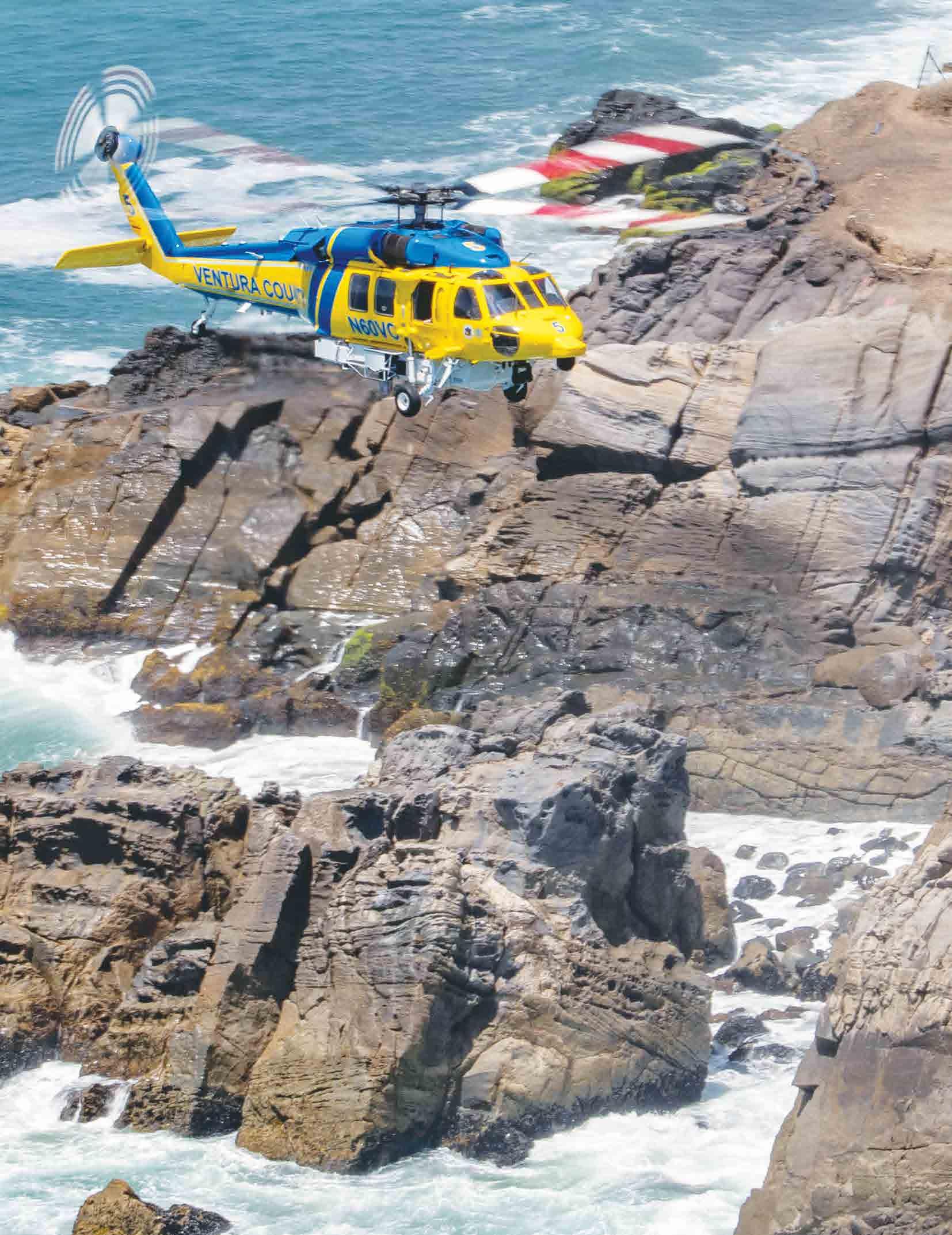
An Erickson Air Crane scoops seawater to drop on fires in Greece.
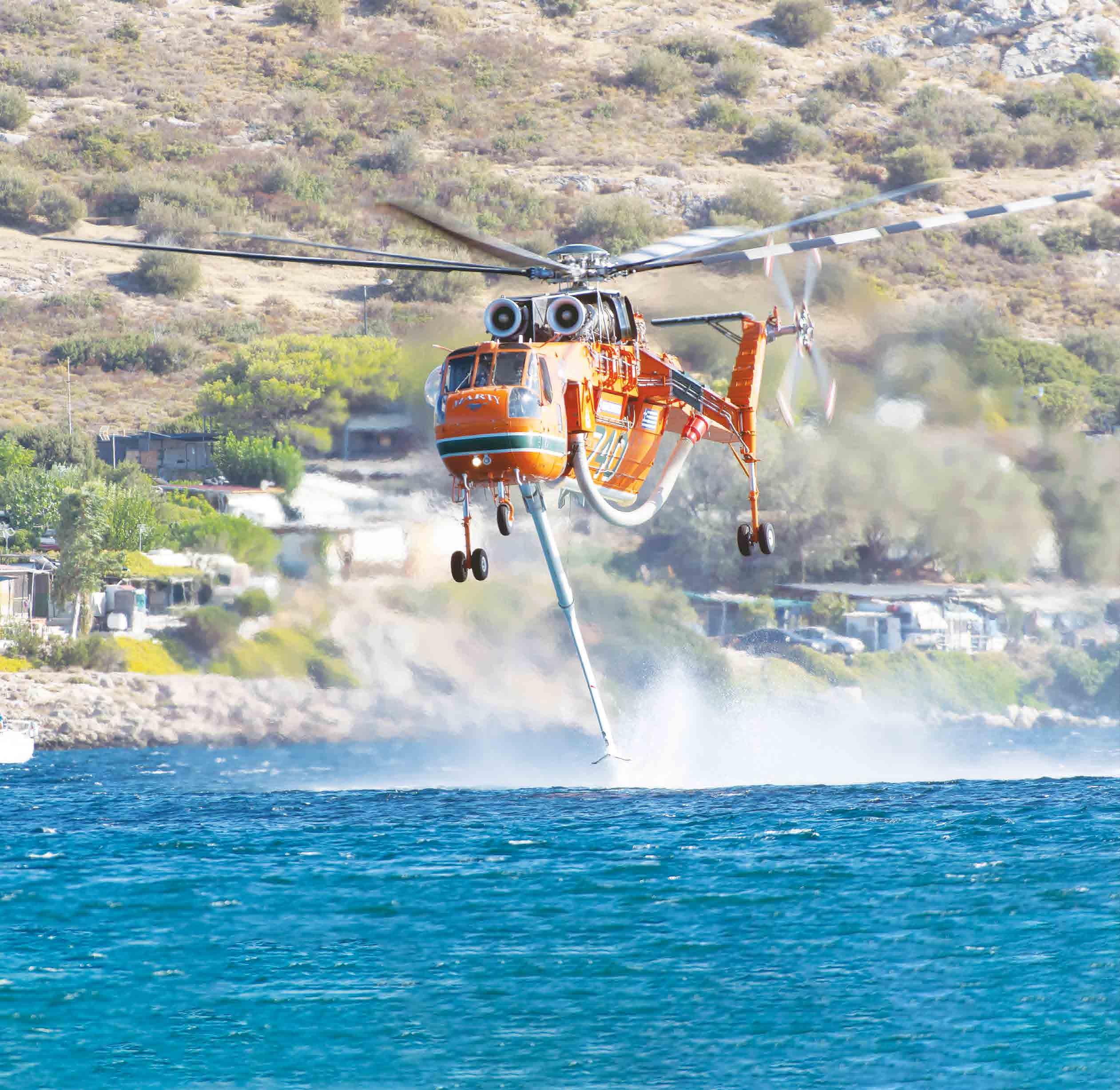
Story and photos by Stamatia Kal & John Pitsakis
Greece Under Fire
The 2021 fire season saw Greece at the forefront of the world stage as the most devastating fire season in many years to hit the country. The largest fires occurred in the Northern part of Evia Island and Western Attica, causing severe ecological destruction for the small Hellenic nation. the 2008-2020 seasons, including a 130% increase in wildfire activation throughout the country. This resulted in the burning of 1,550,000 acres, according to published data from the Greek Forestry Service. Compared to the rest of Europe during the 2021 season, Greece ranked first in the severity of wildfires, followed by Turkey and Italy.

This year’s megafires in Greece, along with the total burned area:
• 8/3 Northern Evia island (508.876 acres) • 8/3 Eastern Mani, Lakonia region (104.712 acres) • 8/3 Varimpompi, Attica region (83.774 acres) • 8/4 Ancient Olympia, Ilia region (180.054 acres) • 8/4 Messinia region (51.067 acres) • 8/5 Fokida region (30.019 acres) • 8/16 Vilia region, western Attica (97.591 acres)
According to Greek authorities, arson was sadly one of the major causal factors of the 2021 fire season. Seventyeight suspects were arrested in forested areas during the 2021 season, 56 cases related to negligence, and 22 cases attributed to deliberate acts of arson. Through published Greek data, authorities attributed 64% of wildfire-affected ignitions in Greece to human factors, with 26% attributed to unknown causes and 10% to natural causes. Meteorological forecasts in Greece had warned of increased temperatures and fire risk brought on by climate change, the total area of wildfire affected throughout Greece in 2021 was 324% higher than the 2020 season, with a 220% increase in forest fires, with the greatest occurrence of wildfires in 2021 occurring throughout August.
Aerial firefighting operations in Greece are usually conducted by various squadrons of the Hellenic Fire Corps, the Hellenic Army Air Corps, and Hellenic Air Force, along with significant contributions by civil contractors including Erickson Air Crane Inc., who provided a fleet of S-64Es along with engineers and pilots stationed throughout Greece.
Fixed-wing assets in Greece consisted of a fleet of PZL (Mielec) M-18B “Dromader” aircraft, affectionately known as “camels,” the original version of the Canadair CL-215s and two variants of the CL-415, CL-415GRs, and CL415MPs, with the latter being also capable of undertaking SAR missions. Rotary assets used in Greece include CH-47 Chinooks from the Hellenic Army Air Corps and 2 Super Pumas from the Hellenic Fire Corps who use a Bambi bucket.
In 2021, Greece leased assets from Russia, Australia, and the U.S. in anticipation of the increased fire danger. Apart from the annual leasing of a Skycrane fleet from Erickson, Greece leased two Bell helicopters (with Mitilineos Group leasing an additional 4 Bell Helicopters) from McDermott Aviation, ➤
CL-415 and CL-215s were some of the many worldwide assets sent to fight this year’s devastating fires in Greece.
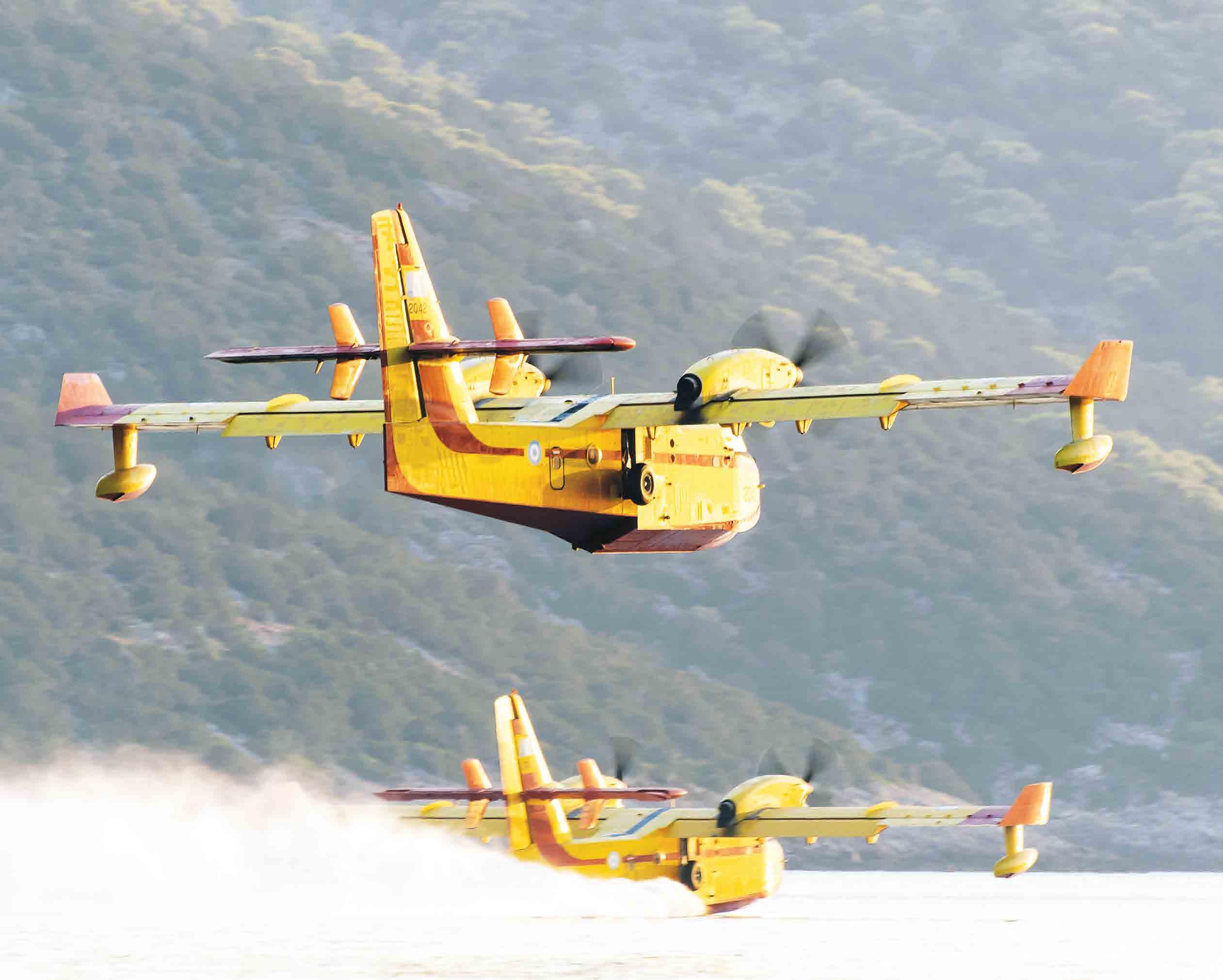
6 Air Tractors from Pay’s Aviation Services including 4 Fire Boss aircraft, 1 Beriev Be-200ES from Russia and a fleet of Mil Mi-171s.
In August, Greece invoked the European RescEU agreement, which enabled additional aircraft from several countries to provide an international response to the fire crisis. Spain and Croatia supplied Canadair CL-215Ts and CL-415s, while Cyprus, Israel, and Sweden responded with Air Tractor Fire Bosses and Russia responded with two modified Illyushin Il-76 aircraft modified with MAFFS systems.
Greece’s first responder aircraft, the PZL (Mielec) M-18 Dromader aircraft, manufactured in Poland intended for export, were purchased by Greece in 1983 and replaced an aging fleet of Grumman biplanes. The aircraft was initially used in crop-dusting and firefighting, and they now are exclusively used as firefighters. They can carry 2500 liters (660 Gallons) of water. To conduct efficient fire operations, Greece’s fleet of pistonengined CL-215s, limited by ambient temperature during startup, were forced to relocate assets to island airports offering a cooler environment to allow the aircraft to take off. Combining a top speed of 157 knots and the ability to load 5000 liters (1350 Gallons) of water in 12 seconds, the CL215s have been a firefighting asset in Greece for more than 45 years.
Greece later invested in the CL-415GR model, which, with two Pratt and Whitney PW123AF engines, lifted the restrictions of the previous model while increasing the aircraft’s top speed to 194 knots. The CL-415GR is a further improved version from the original Super Scooper, with a higher load capacity of more than 6000 liters (1585 Gallons) of water. Comparing the two aircraft, the CL-415 can operate on-site until the last light of the day, while the CL-215 is limited in not being able to operate at night in Greece. At the same time, the 415 has night landing capabilities and can return after civil sunset. ➤
Erickson Air Crane has a long standing relationship with firefighting in Greece along with several other companies such as Australia’s McDermott Aviation

In addition to super scoopers, Greece contracted several Fire Bosses from Pay’s Aviation in Australia.

Regarding the modernization of the firefighting fleet, Greece’s former secretary of Civil Protection mentioned the possible evaluation and purchase of 8 Viking Air CL-515s in the future, which would allow nighttime operations. This investment would come through the funds of the AEGIS program, along with the imminent replacement of the aging PZL fleet.
After the devastating fires in Varimpompi and Northern Evia broke out, Greece requested assistance from any country that could assist, resulting in a massive international response. Qatari, Romanian, Ukrainian, Polish, and French firefighters traveled to Athens and immediately jumped into action. Swedish, Cypriot, and Israeli Fire Bosses, Croatian and Spanish Canadair CL-415s came from neighboring Turkey, assisting in the large Antalya wildfire. Russia supplied three Mil Mi-8 helicopters and 2 Illyushin Il-76TDs. Unlike the other aircraft, these operate like VLAT aircraft, reloading at the airport, capable of dropping 1333 Gallons of water each.

“To effectively manage and tackle the problem of forest fires, the specific characteristics of each region, such as fuel types, landscape, weather, and even the social or economic aspects have to be taken into consideration,” said Dr. Miltiadis Athanasiou, an expert in forest fires who holds a Ph.D. in Wildfire Science from the National and Kapodistrian University of Athens. ➤
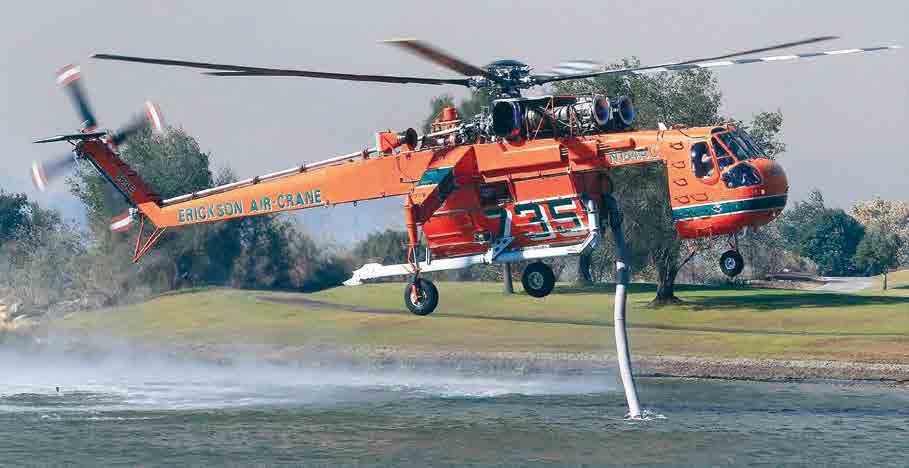
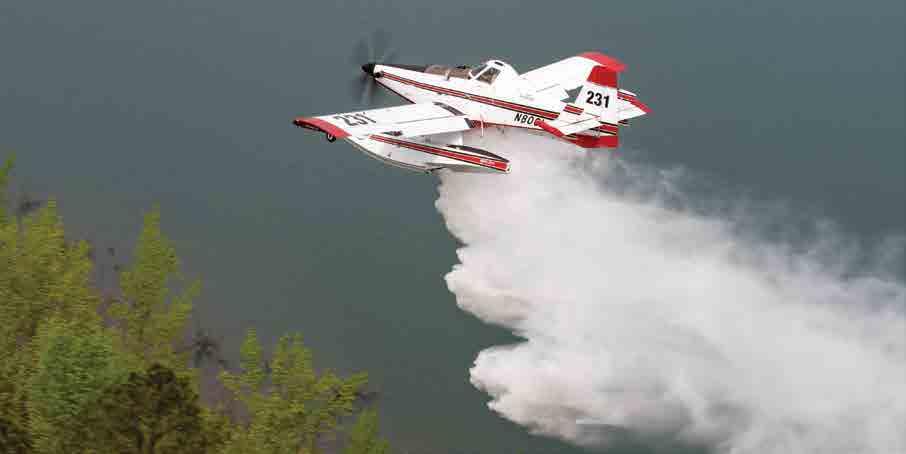
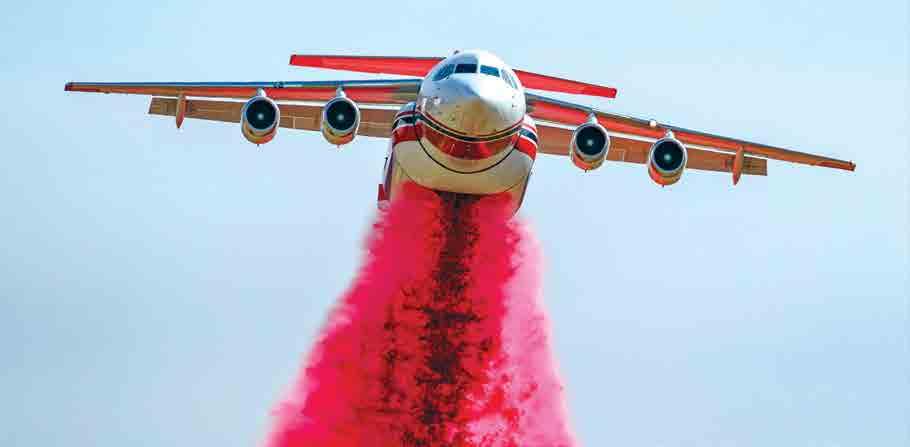

Whether you’re operating Next-Gen Air Tankers, Helitankers or SEAT aircraft, the stress and complexities of your business demand your full attention.
Our attention is focused on building the peace of mind which comes from knowing your business has the proper insurance protection.
• 130+ dedicated Aviation Professionals • Over 50,000 clients in all 50 states • We offer customized, innovative solutions • Unbeatable expertise and service
assuredpartners.com/aerospace

THE RIGHT EQUIPMENT FOR YOUR CRITICAL MISSION!
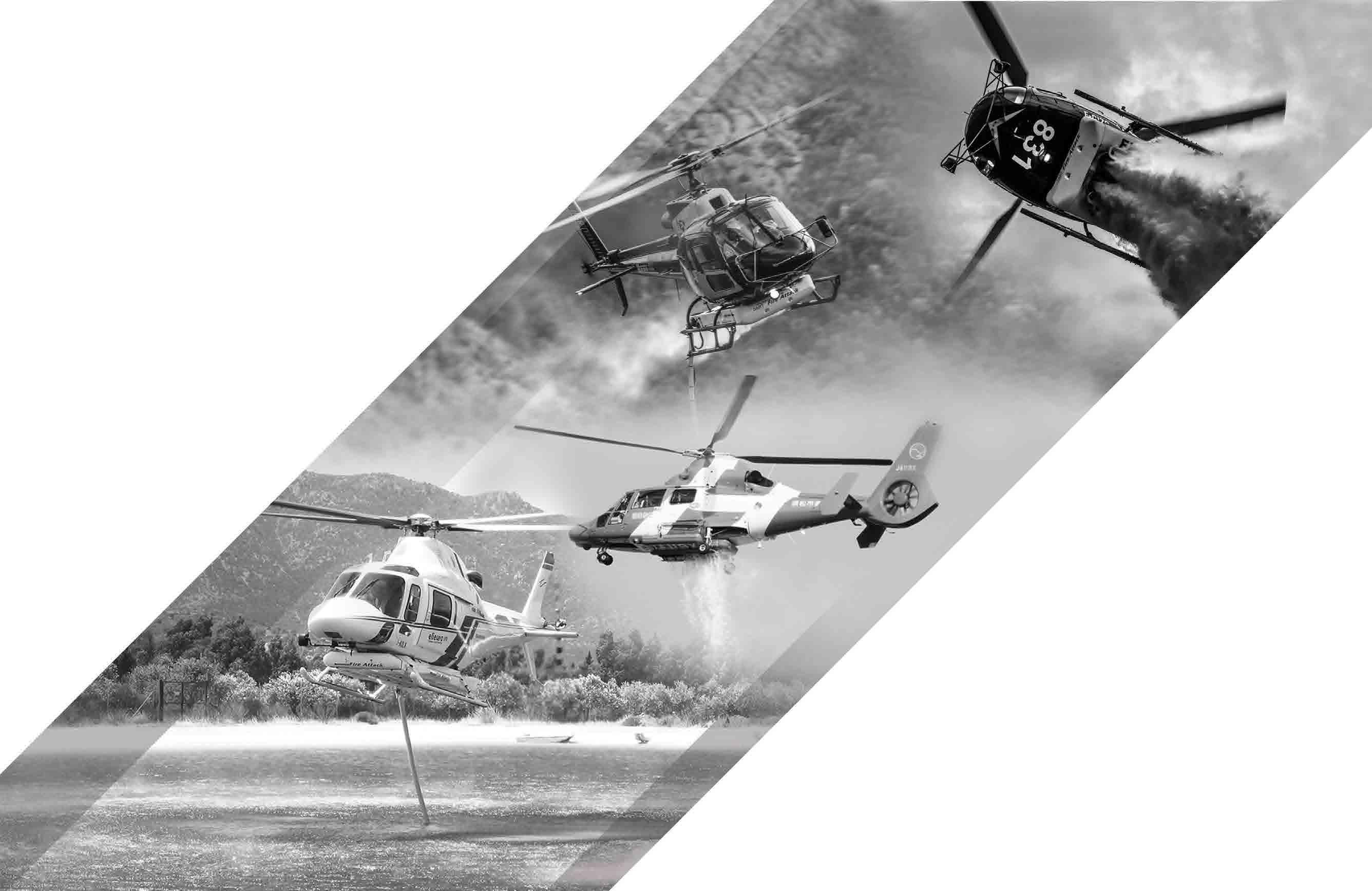
“In ideal conditions, after assessing the threat to the natural and anthropogenic environment, we have to act with preventive public policies. Agroforestry fuel management that matches the green and circular economy and public awareness objectives will help prevent mega-fires. Those efforts reduce fire hazards in strategic locations, mitigate the fire risk, and facilitate fire suppression. There are no ‘cureall solutions’ to the fire problem. We have to help the public learn and act to build community wildfire resilience,” he continued.
While a concern to Greek government officials, wildfires were also a huge concern to Greek residents who were put at risk constantly throughout 2021.
“The fire broke out at noon on the outskirts of the village of Ziria and quickly escalated due to the strong winds that day. The Fire Department rushed to the area and quickly attempted to contain it with the help of the local people. The aircraft arrived roughly three hours after the fire began. The residents attempted to put out the fires, contain them, and keep them outside the village. The Civil Protection Authority’s EAS sent an evacuation order for the villages, including mine and a sports camp located in the region, as the fire was moving towards their locations. It was certain that the fire could not be contained and would reach the shorelines, burning everything in its way. After soaking outhouses with water and locking windows and doors, we moved towards Aegion, hoping that our house wouldn’t be burnt down.” said Nikos Giannopolis, a resident of Loggos village.
2021 will go down in the Greek record books as one of the most significant fire seasons over the last several decades, while the international response that also broke records for a global response to aerial firefighting will also be one of the most significant international responses to an aerial firefighting season in history.
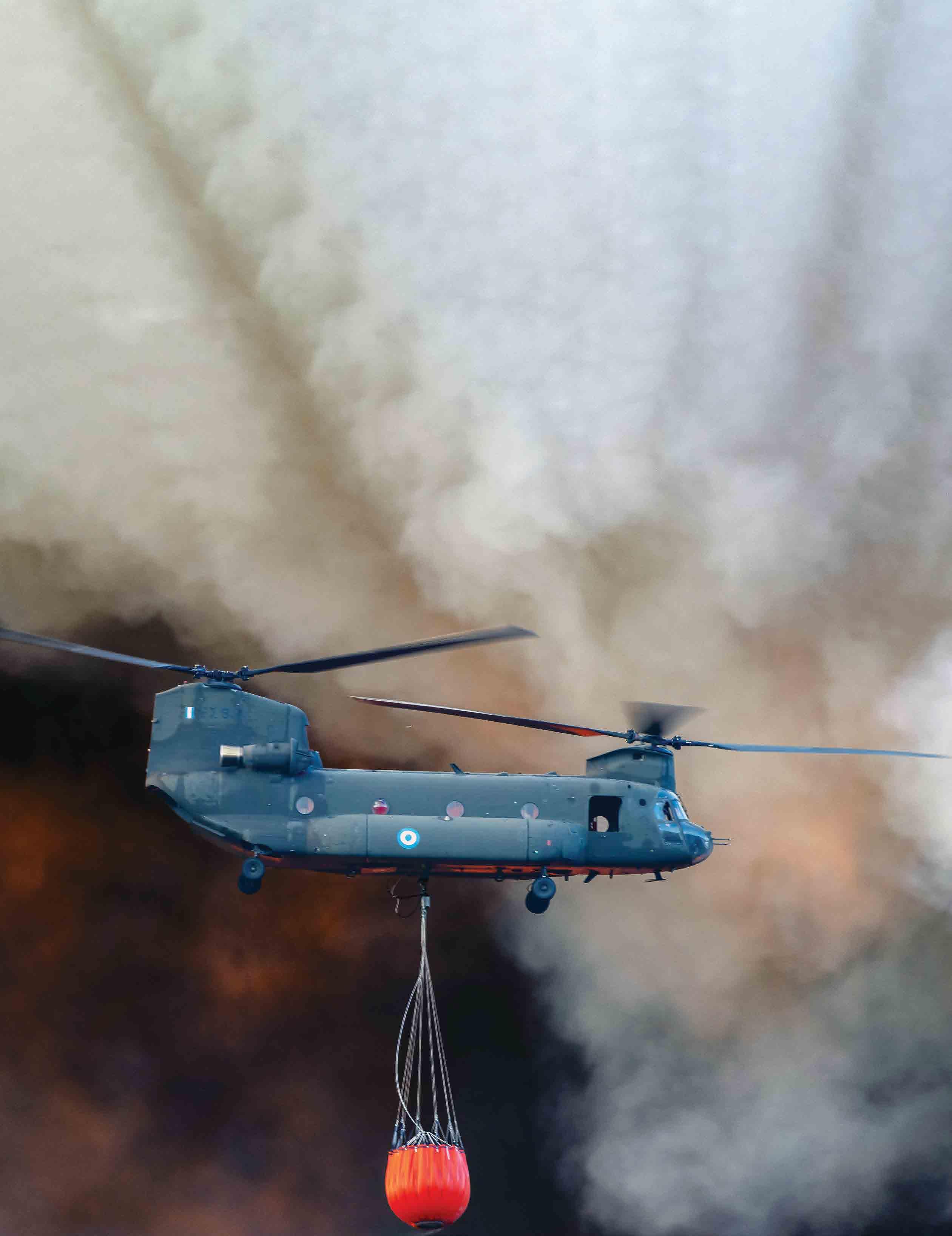
Military assets like this CH-47 form part of Greece’s military response to aerial firefighting each season.
The Right Place at the Right Time
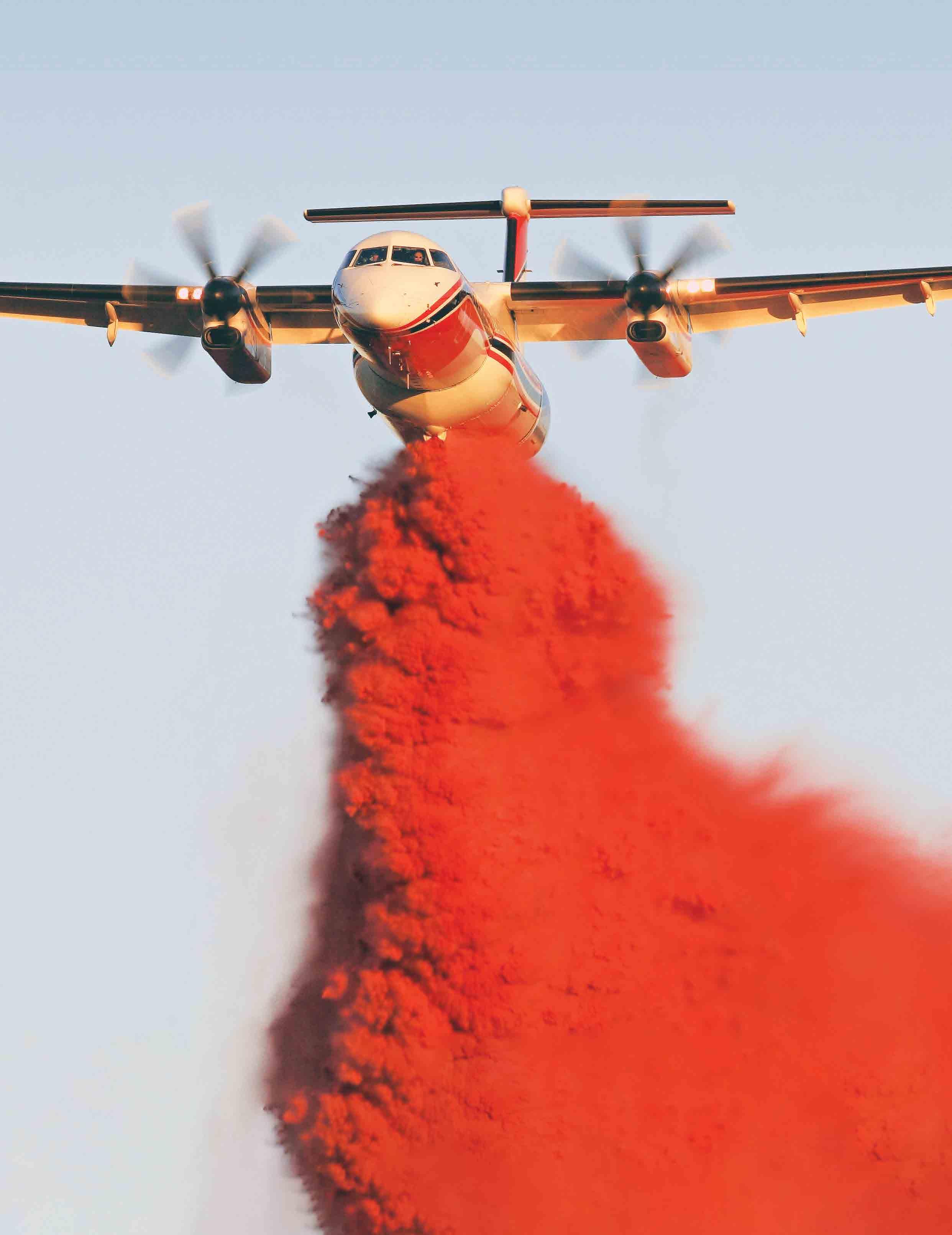
By Ryan Mason
While only a small percentage of wildfires grow into complex infernos, it is these select few that cause the most damage. Wildfires in the
US burned over seven million acres in 2021, and megafires are becoming more prevalent, with seasons extending and requests for air tankers reaching into the winter months. With increased wildfire behavior comes greater demand for additional support. For over 50 years, Aero-Flite has continually grown to meet these needs, responding to an ever-increasing call for more tools to fight wildfires. ➤
Aeroflite, a Conair owned company, is one of two companies that supplies the CL-415 for aerial firefighting in the United States.
Aero-Flite’s methodical approach to diversifying its fleet is designed to support government agencies and firefighters on the ground, offering many aerial options intended to provide the best resources for each mission. Factors such as heat, humidity, wind, fuel type and location play a crucial role in calculating an effective aerial response. Aero-Flite continues to evolve, growing its fleet to fill gaps, offering a range of capabilities that allow agencies to respond to a wide range of wildfire behaviors.
The company operates two main fixed-wing air tanker types, amphibious and land-based. Both are designed to work together as a team, with air tankers laying retardant lines to contain the flames and slow the spread, while super scoopers douse the blaze, allowing firefighters more chances to put out the flames on the ground. Aero-Flite provides both types to agencies, and, by this summer, will offer both Type 1 and Type 2 air tankers, capable of operating out of urban and remote tanker bases with shorter runways. This will allow the company to offer rapid initial attack opportunities by being positioned closer to where fires start.
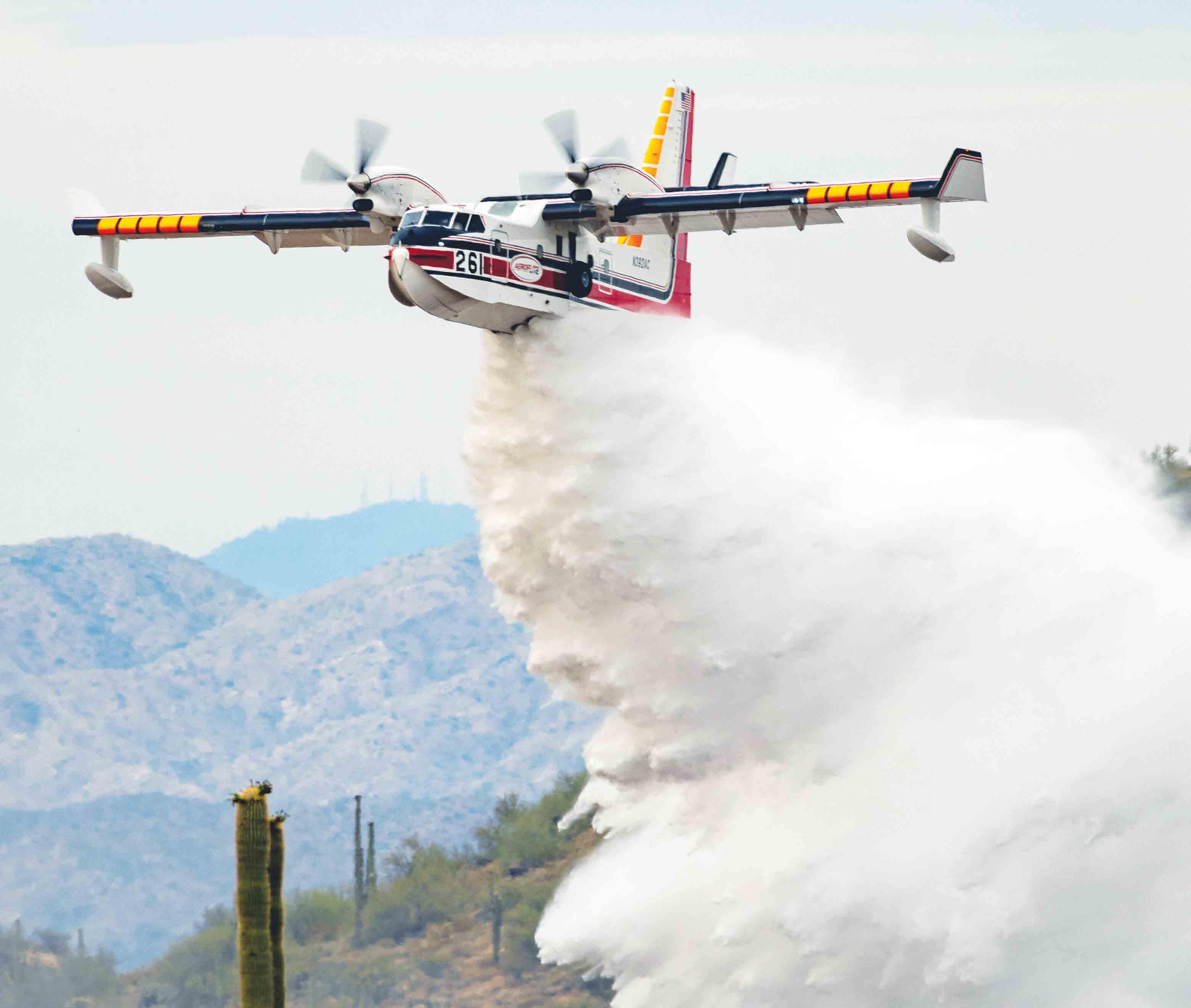
A History of Support
The company first began operations in 1963 based out of Cody, Wyoming, and later Kingman, Arizona, operating radial engine DC4 air tankers and CL-215 water bombers. In 2012 Conair purchased Aero-Flite and retired the legacy fleet, replaced by the Next Generation Type 1 RJ85 air tanker, outfitted with an external 3,000 US gallon / 11,355-liter tank designed to drop retardant or water. Also replaced were the CL-215s, replaced with the newer model CL-415. In 2015, Aero-Flite moved from Arizona to Washington state, making its new home at Spokane International Airport, bringing 40 employees, three RJ85 air tankers, and one amphibious CL-415. Soon after establishing themselves in the Pacific Northwest, the organization grew to a fleet of seven RJ85s and four CL-415s, plus a Pilatus PC-12 dedicated to moving crew and parts, increasing its team of mechanics, pilots and support staff, cementing themselves as one of the largest privatelyowned, fixed-wing aerial firefighting organizations in the US with a team of nearly 170 skilled professionals.
Success Starts with Safe Aircraft
During the firefighting offseason, typically November through March, crews perform maintenance on the fleet, preparing the tankers for deployment the following spring to the lower 48 states. Before deployment, all aircraft undergo enhanced inspections and maintenance to look for and address any wear and tear that inevitably results from aerial firefighting maneuvers. A thorough evaluation of each aircraft, with associated repairs, can take several weeks depending on the size and complexity of the aircraft type.
Supply chain agility and efficiency are the backbones of a strong aviation program as without the parts, aircraft are left grounded. Proactively predicting when aircraft parts will reach their lifespan while anticipating unexpected failures is a complicated dance that weaves together predictive analysis with years of experience. Purchasing and Stores groups work together with Maintenance to have on hand thousands of parts for the wide variety of aircraft types in the fleet, fostering strong relationships with vendors and Original Equipment Manufacturers (OEMs) around the world to secure necessary components when needed.
Conair now operates the RJ-85, the CL-415 and the new Q-400AT both domestically and internationally.
Incorporating Innovation with Impact
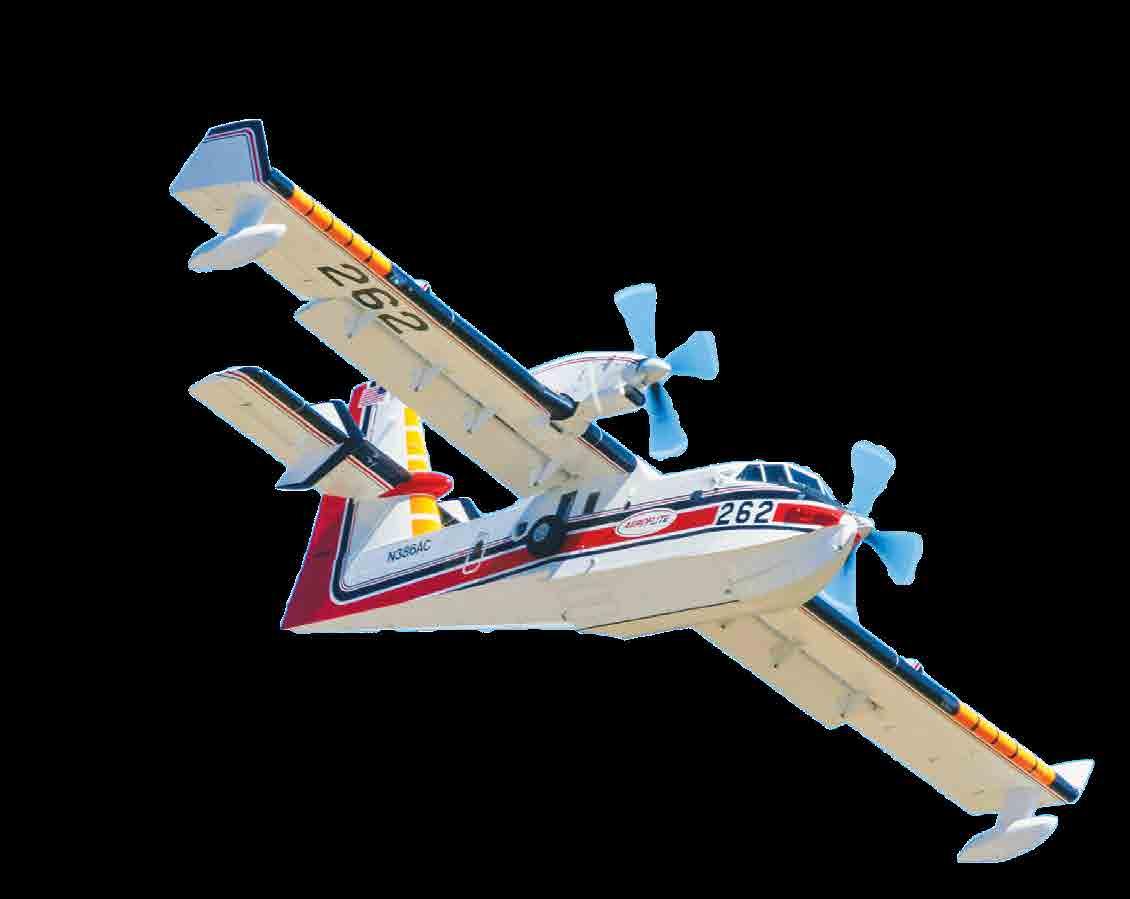
Aero-Flite continuously looks to use technology to improve outcomes, outfitting aircraft with tools that make executing missions more accurate, effective and safer, This includes installing Infrared Red (IR) cameras on the CL-415 fleet and equipping every aircraft with a second FM radio to facilitate better communications with ground firefighters and satellite voice and data communications systems, providing exact aircraft location, flight operation details, drop information and immediate voice contact with the crew.
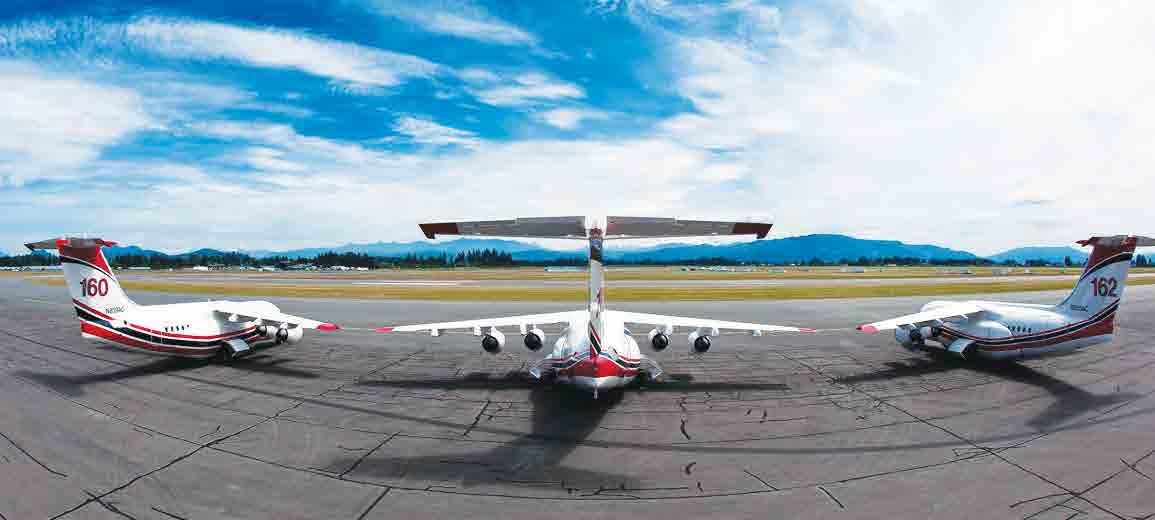
Last year the Aero-Flite CL-415 group was upgraded with a second Angle of Attack gauge, enhancing the crew’s ability to manage the proper energy state on the aircraft avoiding unsafe conditions. In recent years the company’s CL-415 deployments to the American southwest have dramatically increased due to changing wildfire conditions and demand. Due to this change in operations, the CL-415 fleet operates in much hotter conditions, with cockpit temperatures reaching more than 113F. Lowering the cockpit temperature was critical in managing the fatigue of the aircrew. Hence, Aero-Flite undertook several heat management initiatives, including outfitting the aircrew with aviation-grade cooling vests and repainting the nose from black to white, resulting in a 42F cockpit temperature reduction.
Introducing The Dash 8-400AT to the USA
Type 2 size air tanker that offers the punch of a Type 1 while filling a needed and growing niche by giving rural communities access to a large air tanker, positioned from smaller tanker bases that can operate on airports with 5,000’ runways, providing more strategic response and reload options.
The Dash 8-400AT, or the ‘Q’ as its nicknamed, features an external tank, like the RJ85, ensuring the integrity of the airframe is protected while keeping the cabin pressurized and cockpit climate-controlled for pilot safety. The Q provides the speed of jet engine air tankers when flying short distances to wildfires and holds three ‘Time to Climb’ turboprop records. This fast response means a quick turnaround from base to fire and return, speeding up line building.The aircraft’s tank capacity allows for a 2,642 US gallon / 10,000-liter payload while emitting 30% fewer emissions and burning less fuel than air tankers of similar size, translating into both a clean environment and lower cost of operation.
The tanker has been operating in the multi-role version in France for 15 years, providing both air tanker and emergency response services, including medevac, passenger and cargo support. The air tanker version is currently operating its second season in Australia, with a long-term commitment to keep the aircraft on the continent for four years, in addition, entering its second season in Canada and Alaska, operating through Conair in Canada. ➤
Certifying a New Airtanker
The Dash 8-400AT is currently undergoing the final phases of its certification process after finishing its grid test in California in December. COVID had, like many things, forced a pause on testing for nearly two years, with the air tanker being permitted to operate under an interim certificate. Aero-Flite has been training flight crews and aircraft mechanics on the Q and its systems for months, creating a detailed maintenance and regulatory program required by the FAA to certify the air tanker as safe for use. Also in the last stages of development is an entire logistics support program for the air tanker when it repositions to bases around the country during fire season, including trucks, trailers, parts, and tools. And there are preliminary plans in the future to build a new hangar as the fleet grows.
Available When the Call Comes
The Q is a game-changer for Aero-Flite and the aerial firefighting industry. While not the biggest, it is the most versatile air tanker capable of supporting the widest variety of wildfire types, working in partnership with large and small air tankers and amphibious fleets. The Q will be operating for years to come, fully supported by an active Original Equipment Manufacturer (OEM), ready to replace legacy fleets around the country as they age out into retirement.

